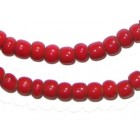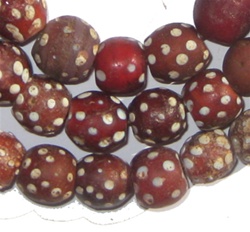How Exotic Cornaline d’Aleppo (White Heart) Beads Got Their Name
Do you ever wonder how certain African trade beads come to get their names? The origins of most African trade beads can usually be determined by their name. For example, Dogon Beads are so called because of their popularity among the Dogon tribe of Bandiagara, Mali. But some, as I've recently come to find out, are a little more misleading.

Red White Heart Beads
Cornaline d'Aleppo (commonly known as "White Heart Beads", or "Hudson Bay Beads" in America) were a popular type of wound and drawn trade bead produced between 1805 and the early 1900s in Venice, Italy. Unlike the more elaborate Millefiori Beads and Chevrons, Cornaline d'Aleppo are rather plainer in appearance, comprising just two layers of different colors. The core is usually white or off-yellow, while the outer layer (which wraps the core) is thicker, and ranges in color from burnt yellow to ruby red. A small quantity were also produced in varying shades of blue around the turn of the 20th Century, however, the most coveted were a seductive shade of dark ruby red. According to historical data, the brilliant red of Cornaline d'Aleppo Beads was the result of adding gold oxide to pink or violet glass.
So, how did they get their name? No-one can say with any great certainty why these Venetian Trade Beads came to have such an exotic name, although, it is thought that French-speaking tribespeople in Mali may have had something to do with it. The word "cornaline" is French for carnelian, a type of agate often used as currency among inter-trading tribes in Africa. "Aleppo" on the other hand, is the name of a small town in Syria. Some suggest the reference to Aleppo was inspired by the fact that it was once an important trading post between Africa and Asia. Nomadic African tribespeople would pass through the city to stock up on supplies, exchanging carnelian beads for essentials such as furs, tools and food. I prefer to believe the name derives from the magical striped stones of Aleppo, famous throughout Africa and Asia for their healing properties.
King Beads: The Mark of African Royalty
"King Beads", so named because of their popularity among tribal leaders during the trade era, are a type of marvered glass bead made in Murano, Italy, during the 19th Century. The earliest known examples of King Beads date back to the mid 1800s, examples of which can still be seen among the Moses Lewin Levin sample bead card collections held at the British Museum, London.
Characterised by their distinctive bicone shape and bold stripes, King Beads were typically larger than striped Chevrons, and were solely intended for use as a trade currency between merchants and African tribes. But, although Venetian King Beads run the gamut of color variations, the most common are green with yellow, red and black stripes. It is thought that such combinations were produced to enhance the appeal of the beads in Africa. Certain tribes, such as the Krobo of Ghana, are renowned for their use of colored beads as a medium of communication, and consider some combinations to be more desirable than others.
Legend has it that the size and specific colors of King Beads was inherent to their popularity among tribal chiefs in the 19th Century. The Anlo Ewe of Benin and Togo regarded these larger beads as being superior to other types of trade beads, and quickly adopted them as wearable symbols of status. Yellow King Beads became central to the Dipo initiation ceremonies in Krobo culture, since the color is associated with coming of age and future prosperity. Interestingly, a number of archeological excavations in Ghana have revealed that some royals were even buried with their King Beads – possibly to aid their prosperity in the afterlife!
Mythical or Medicinal? The Alleged Properties of Skunk Trade Beads
Skunk Beads, (often referred to as 'Eye Beads' due to the intricacy of some

Antique Skunk Eye Beads, Red.
spot designs) are a product of 18th Century Venetian manufacturing. Created using the wound, or drawn glass production method; Skunk Beads represent one of the earliest forms of 'lampwork', a process which involves the addition of small glass globules to a set surface, giving the 3-D raised effect.
Collectors of Venetian trade beads are often in the dark about why Skunk Beads are so named. It is thought the name actually derives from the similarities of the bead design to the coat of the North and Central American Skunk species 'spilogale'. Unlike the native Striped Skunk, the spotted variety are considerably smaller, often with very intricately detailed coats.
Of the many hues of Skunk Beads that have been produced, purists believe that only the black and white variety are true Skunk Beads. The highly collectible red variant were originally known as 'Cornaline d'Aleppo', so named after the Aleppo Stone ('Eye Stone') thought to originate within Syria.
It is possibly from the mythical properties of the Aleppo Stone, that the powers of Skunk Beads for holistic healing have evolved. The agate Aleppo Stone is alleged to be a cure for a prominent Mediterranean skin disease known as the 'Aleppo Boil' or 'Biskara Boil'. The skin condition usually affects the face, and eventually becomes a pus-filled ulcer if left untreated. Carriage or wearing of the spotted Aleppo Stone is thought to rid carriers of the disease, and act as prevention from it.
So too, Skunk Beads are attributed with similar healing powers, despite being made from glass. This could stem from the beliefs of certain African tribes that spirits are omni-present, particularly within beads that are 'of the Earth'. Glass is typically produced from silica and sand, along with several other natural compounds, therefore glass beads are considered 'of the Earth'. Whether or not Venetian Skunk Beads possess holistic benefits; they are still considered some of the most beautiful and collectible of all African trade beads!